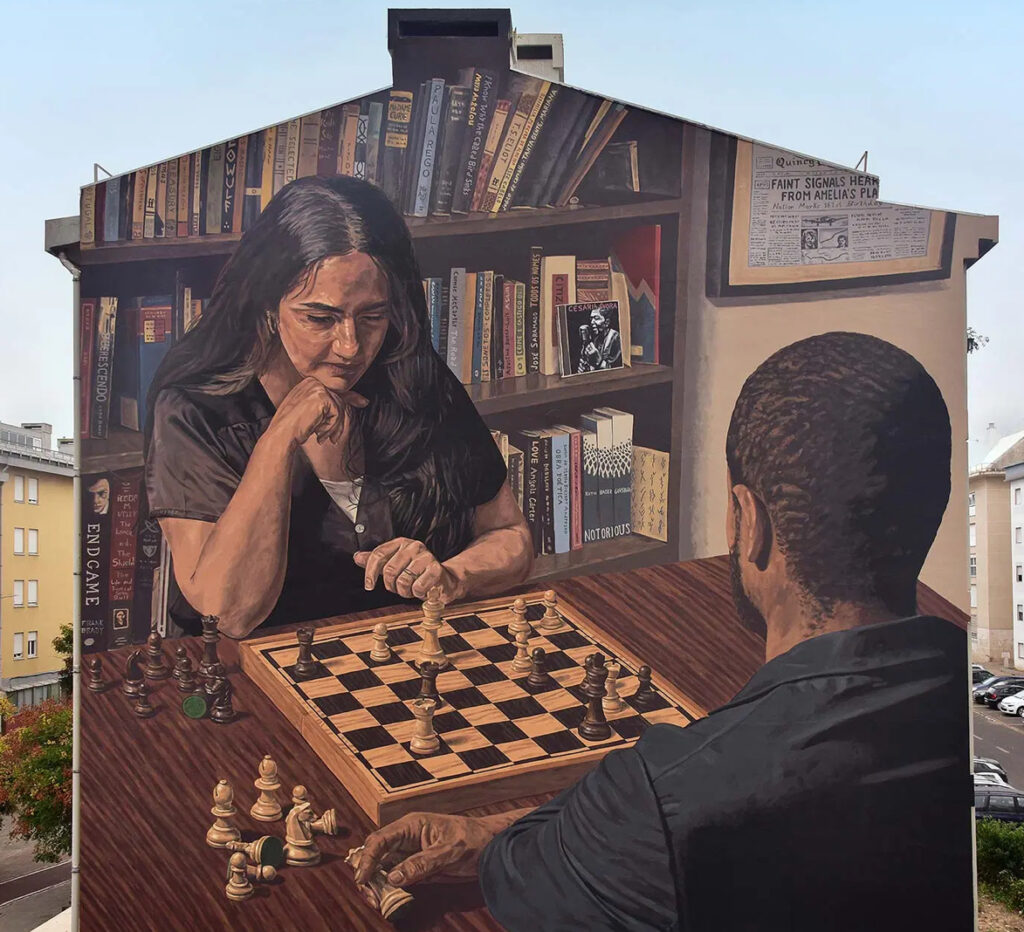In the quiet town of Zambujal, Portugal, a powerful mural titled “Queen for a Day” stands as a beacon of hope and a symbol of transformation. Created by artist Mariana Duarte Santos as part of the Zambujal 360 Project, this work of art encapsulates the spirit of gender equality, a core principle within the United Nations’ 17 Sustainable Development Goals (SDGs). Beyond its vibrant colors and intricate design, the mural carries a profound message about empowering women and fostering societal change.
This article heralds into the significance of “Queen for a Day”, its role within the Zambujal 360 Project, its alignment with the UN’s SDGs, and its broader impact on the discourse surrounding gender equality.
The Artist: Mariana Duarte Santos
Mariana Duarte Santos, a Portuguese visual artist, is celebrated for her ability to translate complex social themes into visually compelling narratives. Her art often explores themes of identity, cultural heritage, and societal transformation. In “Queen for a Day”, Duarte Santos combines her expertise in figurative art with her passion for addressing global issues, creating a mural that resonates deeply with both local and global audiences.
Her work is characterized by a unique interplay of bold colors and delicate details, a style that draws viewers in and invites them to reflect on the deeper meanings embedded within. In this particular mural, her vision of gender equality is not only vividly portrayed but also serves as a call to action for communities to rethink societal norms.
The Zambujal 360 Project
The Zambujal 360 Project is an initiative that aims to transform the small town of Zambujal into a hub for social and cultural innovation. It focuses on promoting the UN’s 17 Sustainable Development Goals, particularly those related to education, equality, and sustainability. The project employs art, workshops, and community engagement as tools for fostering awareness and inspiring collective action.
“Queen for a Day” is one of several murals commissioned under this initiative. Each artwork is strategically placed within the town to create a network of visual narratives that collectively highlight different aspects of the SDGs. The project exemplifies how art can be a catalyst for change, turning public spaces into platforms for dialogue and reflection.
Gender Equality and the UN’s Sustainable Development Goals
Gender equality, as outlined in SDG 5, is a cornerstone for achieving sustainable development. The goal aims to “achieve gender equality and empower all women and girls” by addressing issues such as discrimination, violence, unequal access to education and economic resources, and underrepresentation in decision-making processes.
Incorporating gender equality into initiatives like the Zambujal 360 Project demonstrates how the arts can play a pivotal role in advancing this goal. Public murals like “Queen for a Day” serve as powerful visual tools that communicate these complex issues in an accessible and engaging manner.
“Queen for a Day”: The Symbolism Behind the Mural
The mural “Queen for a Day” portrays a striking image of a woman adorned with a crown, radiating strength, dignity, and confidence. Her posture and expression exude a sense of resilience and empowerment. Surrounding her are intricate patterns and vibrant colors that symbolize diversity, inclusion, and the richness of human potential.
The title “Queen for a Day” challenges traditional notions of power and authority, suggesting that every woman deserves to feel valued, respected, and celebrated. The crown, a traditional symbol of sovereignty, is reimagined here as a metaphor for self-worth and agency.
By situating the mural in a public space, Duarte Santos ensures that its message reaches a wide audience. It becomes a daily reminder to passersby of the importance of gender equality and the collective responsibility to uphold it.
Community Engagement and Improvement
One of the defining features of the Zambujal 360 Project is its emphasis on community involvement. The creation of “Queen for a Day” was accompanied by workshops and discussions that invited local residents to share their perspectives on gender equality. This participatory approach not only enriched the mural’s conceptual foundation but also fostered a sense of ownership and connection among the community.
The mural has become a focal point for community events, educational programs, and social media campaigns. Schools in the area use it as a teaching tool to discuss gender equality, while activists and organizations leverage its imagery to amplify their advocacy efforts.
Art as a Catalyst for Change
Art has long been a powerful medium for addressing social issues, and “Queen for a Day” is no exception. By combining visual storytelling with community engagement, the mural transcends its role as a decorative piece to become a transformative force.
Murals like this serve several key functions:
Raising Awareness: Public art can draw attention to issues that may otherwise go unnoticed.
Inspiring Dialogue: The imagery provokes thought and discussion, encouraging viewers to reflect on their own beliefs and biases.
Building Solidarity: Art creates a shared experience that can unite people around a common cause.
Sparking Action: By making abstract concepts tangible, art can inspire individuals to take concrete steps toward change.
Broader Implications and Global Context
While “Queen for a Day” is rooted in the local context of Zambujal, its message resonates on a global scale. Gender inequality remains a pervasive issue worldwide, affecting millions of women and girls.
The mural’s alignment with the UN’s SDGs highlights the interconnectedness of global challenges. Achieving gender equality is not only a moral imperative but also a prerequisite for addressing other goals such as poverty eradication, quality education, and economic growth.
The mural also underscores the role of cultural initiatives in advancing the SDGs. By integrating art into development projects, organizations can create more inclusive and effective strategies for social change.
Challenges and Opportunities
Despite its positive impact, initiatives like the Zambujal 360 Project face several challenges. Limited funding, cultural resistance, and logistical constraints can hinder the implementation of similar projects.
However, these challenges also present opportunities for innovation and collaboration. Partnerships between artists, local governments, NGOs, and international organizations can help overcome barriers and amplify the reach and impact of such initiatives.
Impression
“Queen for a Day” is more than just a mural—it is a testament to the power of art in driving social change. Through its vivid imagery and profound symbolism, it challenges viewers to reconsider their perceptions of gender roles and embrace the principles of equality and inclusion.
As part of the Zambujal 360 Project, the mural serves as a model for how art can be integrated into broader efforts to achieve the UN’s Sustainable Development Goals. By engaging communities, inspiring dialogue, and promoting action, it demonstrates that creativity and collaboration are essential tools for building a more equitable and sustainable world.
Mariana Duarte Santos’s work reminds us that every step toward gender equality, no matter how small, is a step toward a brighter future for all. Whether through a brushstroke, a conversation, or a collective effort, change begins with the courage to imagine a different world—and the determination to make it a reality.
No comments yet.








